#peter merryman
Explore tagged Tumblr posts
Text

#tv shows#tv series#polls#making fiends#amy winfrey#aglaia mortcheva#peter merryman#2000s series#us american series#have you seen this series poll
127 notes
·
View notes
Text
Some new fiend gijinkas

#myart#fanart#making fiends#gijinka#humanization#amy winfrey#aglaia mortcheva#peter merryman#AU#human au
20 notes
·
View notes
Text
Sorry for the anti Making Fiends hashtag, is that this proshit nonsense stressed me out to the point that I almost hated this artwork that is Making Fiends.
#i love making fiends#makingfiends#making fiends#making fiends my 1st best nicktoons#proud making fiends fan#not a stan is just me saying facts#amy winfrey#aglaia mortcheva#peter merryman#madelaine paxson#vendetta#vendetta vladivkov#charlotte charlston#marvin mai#maggie mishra#grudge vladivkov#making fiends >>> Hazbin Brothel Helluva Shit and Cucktalker#notart#not art#no art#noart#weirdarte's thoughts#weirdarte's ramblings#thoughts#my thoughts#sincerious#sincerity#sincerely#i'm stupid#my struggle
2 notes
·
View notes
Text
Oh crap, there's some cool ideas that could work for them, if Amy Winfrey was doing the series independently, not making the series for television, with an animation studio that will screw you over in the end.
i dont think anyones posted some of these character descriptions from the making fiends section of the old nicktoons website, which SUCKS because it has some pretty cool trivia that wasn’t mentioned in the webseries or tv show.
heres some of the descriptions that come with vendetta, charlotte, and the rest of room 4 vvvv
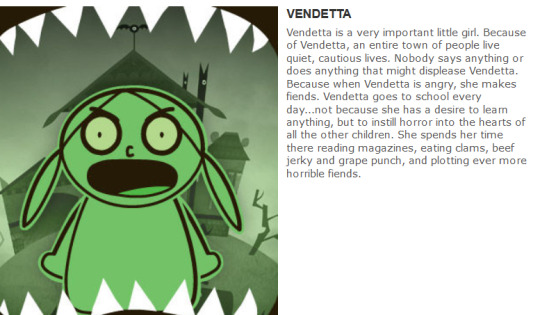
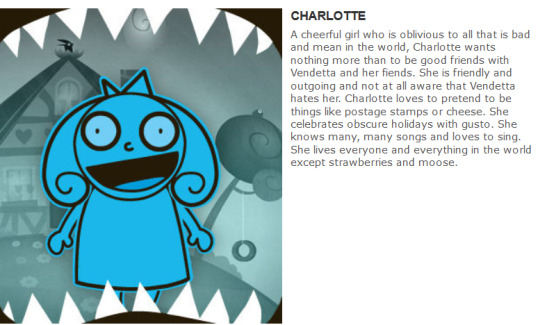
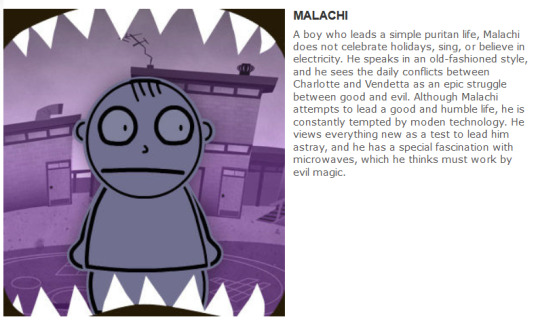
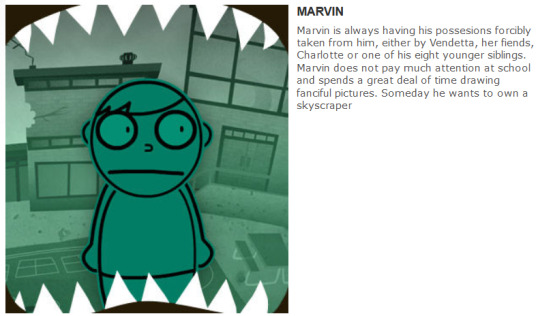
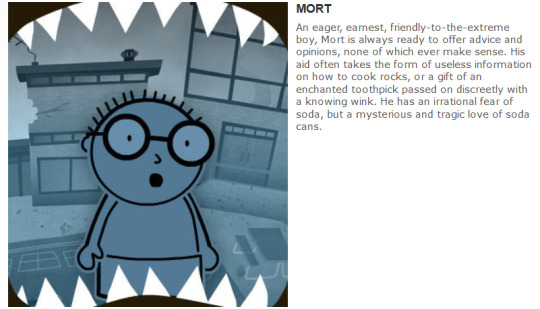
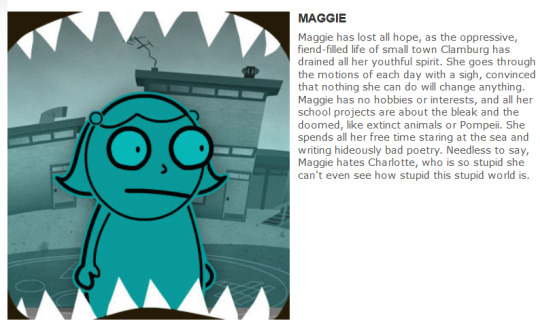
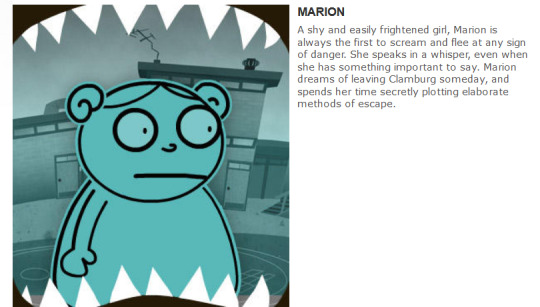
#do what you will with this information#amy winfrey#making fiends#nicktoons#i personally love it#for me Marvin has 1 brother by blood and the rest is adopted#maggie's description is the most interesting#mort description is more funnier#they massacred my girl charlotte charlston#i hate nickelodeon so much#retardalodeon#fuck nickelodeon#nickelodeon give the rights of making fiends back to Amy Winfrey#creathingshitmera please leave the poor Amy Winfrey alone#aglaia mortcheva#peter merryman#madelaine paxson#dave wasson#ego plum#alex hirsch#elissa calfin#chris fria#fred tatasciore#dee bradley baker#rewriter#rewrite#interpretation#headcanons#headcanon#vendetta vladivkov for me is a non binary and bissexual but she discovers it in the adulthood
18 notes
·
View notes
Text
Media Musin’ Monday, #7:
Screw You, Nickalodeon: Making Fiends Deserved Better
I have no idea how anyone could seriously believe that the entertainment industrial complex™ even tries anymore to hold the illusion of a just or meritocratic realm. No holds barred, I have my issues with about every company still clinging like barnacles to the tragic, sinking ship that cable TV has become, but if you want me to point to a network that’s given me an entire skeleton of bones to pick by this point, and I’m underlining Nickelodeon in red at the top of my list.
It’s not because they host some bad shows, no. It’s not a sour grapes reaction to the untimely end of some of my favorite shows either, and though the entire rotten apple situation with creators like Dan Schneider and Butch Hartman certainly added to barrel’s spoilage, I would still feel every bit of my disdain for Nick’s tv group for the one cardinal sin they have committed again and again and again to ad nauseum- their ongoing phase of running a talent slaughterhouse.
It sounds hyperbolic, but I’d call it a fair observation: Spongebob is widely aknowledged as legitimately both the best and the worst thing to happen to this corner of kid’s media, hands down, but I don’t blame the little yellow guy one bit. He’s only another victim to the mess, and as much as I would love to go on a whole dossier spiel of the history of Nickalodeon from the 90s “golden age” to a full list of the dozens of shows and creators their execs have royally fucked over in the name of chasing the ratings dragon… for one, that’s been done a hundred times by other people at this point, and much better than I could. For two, that would take all freaking day. Just off the top of any cartoon savvy person’s head you’d vaguely recall the assassination of Legend of Korra, El Tigre, or Invader Zim, but that can is filled with so many “blink and you’ll miss it” smaller shows that were barely given two steps out of the starting gate, it pads down an entire TVTropes article on the subject. Dozens of them, shows that Nick all but basically set up for failure before quietly shipping them to the peaceful farm upstate- by which I mean shuffled off to inconsistent time blocks and lower priority channels so they could burn out their final approved episodes in hospice. Nicktoons alone garnered a hell of a reputation for exactly what I’m talking about, but that’s show biz, or… something.
Their worst and probably most audacious offense of all? Let me tell you about the fate of the charming world of a little girl who made fiends.

There’s no better place to talk about the end than the beginning.
Making Fiends, I mean, the original Making Fiends was a series of flash-animated shorts among a handful of other early 2000s web cartoons made by Amy Winfrey.
✨ Just, in case you didn’t recognize or feel something for that name, Amy Winfrey is one of the utter beasts of cartoons in general, not purely kids’ media. Songwriter, directing, animation, screenwriting, voice acting… you name a part of the process, and she’s probably dipped her toe in there at some point. Professionally, she broke into the industry contributing work to earliest season of South Park, and while she personally is most known for and associated with Making Fiends, the likely most prominent body of work she’s been a part of would be Bojack Horseman, wherein she’s credited as a director for many of its strongest episodes, including (but not limited to):
- “Free Churro”
- “The Telescope”
- "Sunk Cost and All That"
- “The View from Halfway Down”
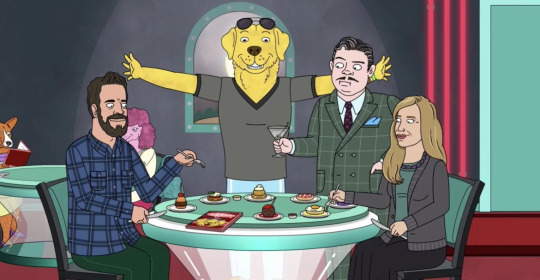
- Amy Winfrey and her spouse (Peter Merryman) making a cameo appearance in the BJH episode “sunk cost and all that”
And even before all of that, she’s been at this animation stuff since the 90s and it shows in a loaded up portfolio of accolades and projects, both professional and personal.
The relevance of this information is to help put in some perspective to just how rotten of a deal she comparatively got with Nickelodeon, when one of those passion creations got a chance to join the network’s airing list.
But to sum up the idea of the web series proper, it independently released 24 short episodes in total, each centered around the antics of two girls engaged in both a completely one sided friendship and nemesis-ship. The show’s namesake refers to the single action the evil little Vendetta is most known for- creating a variety of servant monsters, many of which she uses to secure her rule over the port town of Clamburg, and all its inhabitants. Charlotte, on the other hand, is the quintessential “children’s show” character: near inhumanly kind, cheerful, and naive. So much so that she’s oblivious to her “best friend’s” near daily attempts to murder her, or the fact that she, you know, despises her.
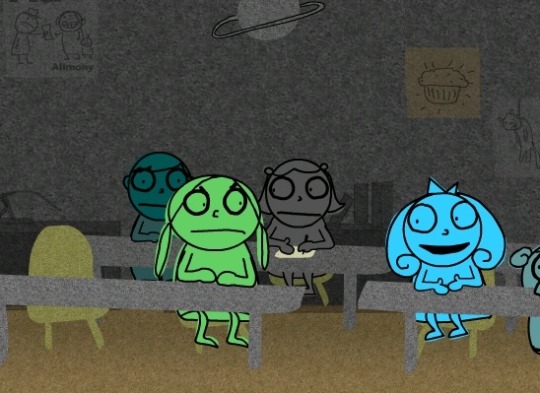
In 2006, Nickelodeon took an interest in Winfrey’s toon and the prospect of adapting it into a TV series, reportedly because a daughter of a studio employee was a huge fan.
And fun fact btw, this was actually the first time that Nick did this approach of turning an indie web animation into one of their shows, but it certainly wasn’t the last if you remember this was also the origin of Breadwinners.
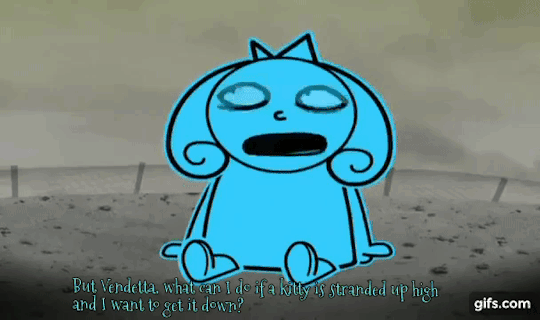
And as far as the audience was concerned, it was quite the successful transition! The TV version pretty much kept all of the major beats and vibes of the original, with polished animation, the same voice actors, and some stylistic upgrades to the art/environmental designs. For a brief time, it was the highest rated thing on its release channel too. Someone I don’t quite recall the name of once endearingly referred to the show as “baby’s first grimdark” and I adore how fitting of a summary that is. It sports a charmingly unique art style, memorable soundtrack, and I can swear to y’all, the humor aged like a fine wine.
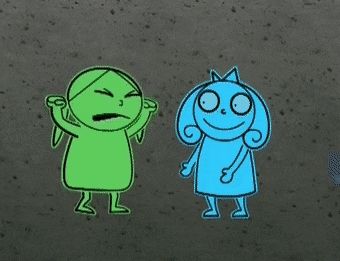
“Why don’t you pretend to be dead?”
“:) ok!”
*slam*
(Also, sidenote, the entire series is still up on your tube, in HD, completely free to watch!)
So, if it’s such a neat little show, then why on earth does barely a soul seem to remember it existing? And even fewer scare who recall knowing about the show during its 2008 release?
Because Nickelodeon Studios, without hyperbole, set this show up for failure at every single turn before it even got a fighting chance.
People know of some shows that Nick treated like garbage, but this one they treated like absolute shit for reasons I can’t fathom.
Making Fiends, for one, never actually saw the light of day on the main network channel, as per the original plans. It was actually instead delegated over to Nick’s sister channel, Nicktoons, by a last minute decision.
Nicktoons, fyi, was not carried by most cable packages. I obviously lived on it as a kid, and it was functionally to Nick what I remember Boomerang being to Carton Network- the cable block where reruns of much older but loved shows were shoveled off to once they finished their days on the main channel.
Second, it was quietly premiered with barely a couple farts of advertising, too. I remember maybe seeing one preview as a kid, on Nicktoons.
And I guess, not keeping either of these in mind, Nick then abruptly pulled the plug on the whole thing, citing the tried and true “low ratings” explanation and leaving it at that.
Not counting years of post-cancelation reruns, the show actively ran from October 4, 2008, to November 1, 2008.
That is roughly a month between premiere and the end production date.
One season. Six entire episodes.
Seven whole additional completed scripts abandoned on the table.
Yeah.
I’m a touch salty about it still.
And with the shutting down of the Nicktoons network social media in 2018, any additional acknowledgment of the show from Nickelodoen themselves has kind of vanished to my knowledge. Like, it’s almost no wonder you already had to be part of the cult following to know about it, when Nick has been quiet about the calf they sent to auction since. Worst part is, they still hogged the rights to the show instead of idk, wild idea, giving it back over to Winfrey. I can only imagine people get away with entire reuploads of the series under the otherwise very IP protective Nick’s nose as another display of how low and bastardly those execs really view Making Fiends.
And that sucks! Wow! But I guess in a “be happy it happened, not sad it ended” way, I’m kind of glad for the fact that we can still enjoy and pass around the show that we did get to experience at all, rather than see it fade into true lost media territory.
Even today, about 16 whole years later, I know for a fact there are still plenty of other fans that remember and cherish the splash this tiny show made in that big, brutal pond. So, in that manner, you can’t truly call Making Fiends dead and gone.
A bittersweet story to think about, and only one of many down a long list, but ultimately one I’m happy to be able to tell at all.
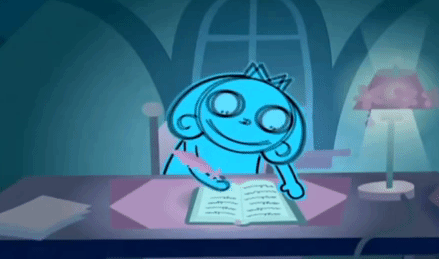
Even if all the while still raising a giant middle finger to the network for the ending.
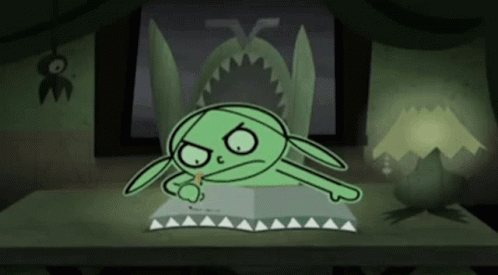
#media musin’ mondays#mm’m#making fiends#nicktoons#amy winfrey#nostalgic cartoons#scarlet talks about things#enthusiastic recommendations#long post
51 notes
·
View notes
Photo


BoJack Horseman, 2018
#animation#comedy#drama#bojack horseman#season 5#ancient history#raphael bob-waksberg#will arnett#peter merryman#rachel kaplan#provisions
20 notes
·
View notes
Text
Yeah, i want to see your face after Fox (Fax), Cartoon Network (Cunt Network), Netflix (Notflix), Disney (Dick) and Viashit sue you for drawing all the bad things in the world and bringing them into innocent works and you call all this crap art? Sincerely ShitmeraCreations/ Creathing Shitmera screw you, you don't deserve support for everything you've done, when Amy Winfrey, Aglaia Mortcheva and Peter Merryman find out what you've done they will criticize you, block you and report you because no one deserves to see these disgusting things that you think are art and fiction.


Good luck selling illegally copyrighted making fiends merchandise by nick property creatingshitmera….
Nickelodeon and Viacom will seeking damages by creatingshitmera more often then BAM a class action lawsuit definitely sued seized and desist copyright infringement owe them a huge amount of fines…… but that’s creatingshitmera sacrifice that he is willing to make….
You don’t sell copyrighted merchandise illegally gotta ask and approve to nick or Viacom
#creatingshitmera#my singing monsters#Amy Winfrey#Aglaia Mortcheva#Peter Merryman#CreathingShitmera please leave Amy Winfrey alone#just stop#hypocrisy#viashit#viacom#paramont#parashit#uglydolls#smiling friends#makingfiends#making fiends#making farts#hazbin brainrot#helluva shit#Vivziepoop#CreathingChimera critique#Creatingchimera critical#CreathingShitmera critique#CreathingShitmera critical#Vivziepoop critique#Vivziepoop critical#the grim adventures of billy and mandy#Irwin Dracula#Nergal jr#grim adventures of billy and mandy
4 notes
·
View notes
Text
In this episode of animated TV, a Toucan woman has the most accurate experience of navigating healthcare with endometriosis I’ve ever seen.
27 notes
·
View notes
Photo





BoJack Horseman season 5 episode 9 "Ancient History" (2018) dir. Peter Merryman
486 notes
·
View notes
Text
Bojack Horseman: Season Six (2019)
Format: A single season of an animated TV show.
Directors: Peter Merryman, Amy Winfrey, Mollie Helms, Adam Parton, Aaron Long, and James Bowman.
Writers: Raphael Bob-Waksberg, Elijah Aron, Nick Adams, Alison Tafel, Peter Knight, Rachel Kaplan, Minhal Baig, Shauna McGarry, Joe Lawson, Joanna Calo, Jonny Sun, and Amy Schwartz.
Is J.K. Simmons in this? A little bit, yes.
Who does he portray? Lenny Turtletaub, an anthropomorphic turtle and movie studio executive. He also portrays an anthropomorphic horse preacher.
What does he do? As Lenny Turtletaub, he mainly tries to break a strike and get various movies made. As the horse preacher, he gives a very uplifting sermon.
How bald is he? Well, the horse preacher has a very full mane. Turtletaub also appears to be not bald, but I believe that that’s a hairpiece.
Is anybody else in this? Yes, a healthy mix of humans and anthropomorphic animals are in this.
Is it worth seeing if I’m not a J.K. Simmons completist? Definitely, although I’d recommend watching the first five seasons before doing so. In any case, this season continues the balance of humour with dissection of its characters and social satire. The really unique and welcome thing about this season is that in the previous seasons the show’s protagonist would do terrible things that would generally have awful consequences for the people around him. This season both shows the inverse of that (he tries to reform and do good things, which leads to the lives of the people around him improving) and brings some of the consequences of the awful things he’s done back to him. It’s heartbreaking to see, but it’s also refreshing to see a piece of art be so honest about the difficulty of breaking out of toxic patterns. I’m sorry this show is over now, but I also don’t see how it could have ended any other way.
1 note
·
View note
Text
Merry Men
read it on AO3 at https://ift.tt/3x8xoJX
by copper_dust
Kontum, South Vietnam, 1968.
One time, in line for chow at Firebase Merryman, Macmillan from Echo Three whispered to Black, “I like Moony and all, but you think you’ve seen all the way to the bottom of it and come out alright until you look at his eyes, and you realize he’s way down deeper than you, and he’s seen it, he’s seen that there is no bottom.”
Black wasn’t sure he agreed on that analysis.
Words: 10467, Chapters: 1/?, Language: English
Fandoms: Harry Potter - J. K. Rowling
Rating: Explicit
Warnings: Graphic Depictions Of Violence, Major Character Death, Rape/Non-Con
Categories: F/M, M/M
Characters: Sirius Black, Remus Lupin, James Potter, Peter Pettigrew, Kingsley Shacklebolt, Regulus Black, Tom Riddle | Voldemort, Benjy Fenwick, Severus Snape, Stubby Boardman, Albus Dumbledore, Minerva McGonagall, Cornelius Fudge
Relationships: Sirius Black/Remus Lupin, Sirius Black & James Potter, Remus Lupin & James Potter, James Potter/Lily Evans Potter, Sirius Black & Remus Lupin & Peter Pettigrew & James Potter, Regulus Black & Sirius Black
Additional Tags: Slow Burn, Alternate Universe - Non-Magical, Alternate Universe - Vietnam, 1960s, Soldiers, Alternate Universe - Historical
read it on the AO3 at https://ift.tt/3x8xoJX
0 notes
Text
Merry Men
read it on the AO3 at https://ift.tt/3x8xoJX
by copper_dust
Kontum, South Vietnam, 1968.
One time, in line for chow at Firebase Merryman, Macmillan from Echo Three whispered to Black, “I like Moony and all, but you think you’ve seen all the way to the bottom of it and come out alright until you look at his eyes, and you realize he’s way down deeper than you, and he’s seen it, he’s seen that there is no bottom.”
Black wasn’t sure he agreed on that analysis.
Words: 10467, Chapters: 1/?, Language: English
Fandoms: Harry Potter - J. K. Rowling
Rating: Explicit
Warnings: Graphic Depictions Of Violence, Major Character Death, Rape/Non-Con
Categories: F/M, M/M
Characters: Sirius Black, Remus Lupin, James Potter, Peter Pettigrew, Kingsley Shacklebolt, Regulus Black, Tom Riddle | Voldemort, Benjy Fenwick, Severus Snape, Stubby Boardman, Albus Dumbledore, Minerva McGonagall, Cornelius Fudge
Relationships: Sirius Black/Remus Lupin, Sirius Black & James Potter, Remus Lupin & James Potter, James Potter/Lily Evans Potter, Sirius Black & Remus Lupin & Peter Pettigrew & James Potter, Regulus Black & Sirius Black
Additional Tags: Slow Burn, Alternate Universe - Non-Magical, Alternate Universe - Vietnam, 1960s, Soldiers, Alternate Universe - Historical
read it on the AO3 at https://ift.tt/3x8xoJX
0 notes
Text
Abraçu de Amigo.






Sorry @wh6though7.
#buttonsll#buttons ll#buttons2#buttons 2#buttons ll making fiends#making fiends buttons ll#buttons 2 making fiends#making fiends buttons 2#chainber#chainber making fiends#making fiends chainber#making fiends art#making fiends fanart#making fiends drawing#makingfiends#making fiends#amy winfrey#aglaia mortcheva#peter merryman#madelaine paxson#gloomy bear#making fiends memes#making fiends meme#ibis paint x#ibispaintx#digital#illustration#drawing#painting#my artwork
5 notes
·
View notes
Photo

Título original BoJack Horseman (TV Series)
Año 2014
Duración 25 min.
País Estados Unidos
Dirección Raphael Bob-Waksberg (Creator), JC Gonzalez, Amy Winfrey, Joel Moser, Martin Cendreda, Adam Parton, Mike Hollingsworth, Matt Mariska, Mike Roberts, Anne Walker Farrell, Aaron Long, Matt Garofalo, Otto Murga, Tim Rauch, Peter Merryman
Guion Raphael Bob-Waksberg, Joe Lawson, Peter Knight, Elijah Aron, Jordan Young, Mehar Sethi, Vera Santamaria, Kate Purdy, Joanna Calo, Scott Chernoff, Alison Flierl, Kelly Galuska, Laura Gutin, Scott Marder, Caroline Williams, Alison Tafel, Nick Adams, Rachel Kaplan
Música Grouplove, Jesse Novak
Fotografía Animation
Reparto Animation
Productora Emitida por Netflix; ShadowMachine Films / Tornante Company / Netflix. Productor: Lisa Hanawalt
Género Serie de TV. Comedia. Drama | Comedia dramática. Comedia negra. Cine dentro del cine. Televisión. Animación para adultos
Web oficial https://www.netflix.com/title/70300800
Sinopsis Serie de TV (2014-Actualidad). En un mundo donde humanos y animales antropomórficos conviven, el protagonista de la serie es el caballo BoJack Horseman (Will Arnett), protagonista de la telecomedia "Horsin' Around" en la década de los 90. Después de años de decadencia y una tormentosa vida personal, BoJack se propone volver al candelero a través de una autobiografía para la que contará con ayuda de una escritora fantasma, Diane Nguyen (Alison Brie). Pero BoJack también tendrá que lidiar con las exigencias de su exnovia y agente, la gata Princess Carolyn, su compañero de piso, Todd Chávez, y su amienemigo Mr. Peanutbutter, un perro labrador que es novio de Diane y triunfó con una sitcom muy similar a "Horsin' Around".
Premios 2018: Premios Annie: Mejor producción animada para TV y doblaje 2017: Premios Annie: Nom. a Mejor producción animada para TV, doblaje y montaje 2016: Premios Annie: Nominada a Mejor producción animada para TV 2018: Critics Choice Awards: Mejor serie de TV - Animación 2017: Critics Choice Awards: Nominada a Mejor serie de TV - Animación 2016: Critics Choice Awards: Mejor serie de TV - Animación 2015: Critics Choice Awards: Mejor serie de TV - Animación 2017: Sindicato de Guionistas (WGA): Mejor guión en una serie de animación 2016: Sindicato de Guionistas (WGA): 2 nominaciones a Mejor guión serie animación 2015: Sindicato de Guionistas (WGA): Mejor guión en serie animación
0 notes
Text
May 13, 1720 - Coming This Weekend: The Amorous Widow
For the Benefit of Mrs. Boman, Miss Purdon, and Miss Seal.
By His Majesty’s Company of Comedians.
At the Theatre Royal in Drury-Lane, To-morrow being Saturday the 14th of May, will be presented, A Comedy call’d, The Amorous Widow: Or, The Wanton Wife. The Wanton Wife by Mrs. Oldfield, Barnaby Brittle Mrs. Norris, Lovemore Mr. Wilks, Cunningham Mr. Mills[?], Sir Peter Pride Mr. Johnson, Merryman Mr. Pinkethman[?], Clodpole Mr. M Mrs. Saunders, Lady Pride Mrs. Willis, Damaris Mrs. Bicknell, Philadelphia Miss Sea[?]. To which is added, a Farce call’d Hob, or the [C]ountry Wake. With Entertainments of Dancing.
Daily Courant (May 13, 1720)
0 notes
Link
Warning: This article contains spoilers for Bojack Horseman.
What do you see when you look into the eyes of Bojack Horseman?
Do you see anxiety? Do you see dysfunction and excess and addiction? Do you see yourself?
The creators of Bojack Horseman hope to conjure all these thoughts and more—but before the show even really begins. The 40-second title sequence, shown at the top of each episode, is instrumental in building the show’s tone and mythology. It changes subtly over the seasons and even from one episode to the next, exposing emotional subtexts and foreshadowing plot points. “It’s tremendously important—I definitely think it’s affected the show,” Bojack creator Raphael Bob-Waksberg tells TIME.
But the title sequence’s biggest impact isn’t uncovered until the show’s penultimate episode, which was released on Netflix on Jan. 31. In that episode, it’s revealed that the show’s climactic moment has been hiding in plain sight from the very beginning. This long payoff, six years in the making, is just another small but key example of how Bojack has been one of the smartest and most transgressive shows on television in recent memory.
Lost-in-life feeling
While Bojack is now widely revered, its fate was much less certain when the filmmaker Mike Roberts was brought on to direct the title sequence in 2014. For the most part, adult animation was confined to a specific lane—largely consisting of crude jokes aimed at teenage boys—and the first few episodes of Bojack hewed dangerously close to that standard.
“The first three episodes didn’t give everyone the full picture of how serious and dark and thematically deep the show goes,” Roberts tells TIME. “The main thing was to let the audience know that it wasn’t just this typical show—that there was some depth coming.”
In creating the title sequence, Roberts hoped to take viewers on a tour of Bojack’s everyday life—just like the introduction to The Simpsons and Scooby Doo—but from a peculiar vantage point: as if a GoPro was locked facing Bojack’s head. Roberts says he was primarily inspired by YouTube travel videos and how unintentionally strange they are: “It has this weird sensation of being there but also not being there, because the person is such a large part of the frame,” Roberts says. “We wanted this lost-in-life feeling, as if you were on a vacation somewhere exotic but stuck in your life that you kind of hate.”
The sequence shows Bojack walking through his house, going to the supermarket, partying with friends, and falling into a pool. But while his day is action-packed, he doesn’t seem to be in control—his body drifts automatically through space, wobbling slightly. “We wanted to feel like the day was running away from him,” Roberts says.
The sequence also communicates a disconnect between Bojack and those around him. Because Bojack faces the viewers, he can’t actually see the people that populate his house, and thus mostly doesn’t react to them at all. While he moves fluidly, the other characters flicker in stop-motion, as if they they’re not quite real to him. The amount of space Bojack’s own face takes up in the frame also reflects his narcissism and his inability to see the world outside of himself.
And the sequence not only gives the viewer clues about Bojack’s disorienting headspace, but forces us into it. Bojack’s blank stare has a startling mirroring effect, as if you were staring at your own reflection through the window of a moving train. “The feeling of the camera being locked to you while the background is moving is so surreal and weird,” Roberts says. “In some ways, it feels a bit like being drunk or being high.”
While the visual sequence was arresting on its own, the accompanying music would also be crucial in signaling the show’s tone. After culling through options, the creative team ultimately came down to two pieces: an instrumental by Patrick and Ralph Carney propelled by braying saxophones, and a melancholic ditty by Grouplove. “The Carney song was intense—almost a film noir kind of thing, while the Grouplove song was scary-funny in a Lynchian way,” Roberts said. “As we overlaid them, it was obvious which one fit.” They chose the Carney song, with its sinister haziness, for the top of each episode, and then moved the Grouplove song to the end credits as a pitch black resolution.
“You’d feel the momentum”
Bob-Waksberg loved Roberts’ concept: “It illustrated what the show was going to be even when the show itself was not illustrating that,” he says.
But he wasn’t completely satisfied—and he asked that the sequence reflect another key aspect of the show. “One of the things that set us apart early on, as opposed to other animated shows, was the fact that Bojack was continuous and serialized,” Bob-Waksberg says. While other animated sitcom protagonists, like Homer Simpson, Peter Griffin and Sterling Archer, perform reckless actions that are mostly wiped clean at the end of each episode, Bojack’s life doesn’t reset; his decisions have devastating consequences to himself and those around him.
Bob-Waksberg wanted to use the title sequence to underscore those continuing repercussions—”so you’d feel the momentum of the series.” So Roberts and his team worked to implement small changes to the background of each episode’s title sequence. Some of the changes are little more than fun easter eggs: when Todd jumps on Bojack’s bed and breaks it, for example, his bed is propped up by books the next episode.
But other changes are far heavier: they document the end of relationships (with Wanda and Gina quietly disappearing) or show how Bojack’s actions have affected the outside world (after he gets the director Kelsey Jannings fired from Secretariat, she’s summarily replaced in the sequence by Abe D’Catfish). Before it’s revealed that his mother Beatrice has been drugging his sister Hollyhock through coffee, Beatrice is shown pouring a cup for her at the beginning of each episode.
And as the series goes on and Bojack devolves deeper into addiction and narcissism, the title sequence changes even more drastically. In season four, the segment that previously showed Bojack finally leaving his house is replaced by a kaleidoscopic montage of characters, signifying his past and present collapsing, his mental grip on reality spiraling out of control. (The sequence is triggered by Bojack drinking coffee, which also could be a nod to Beatrice’s sleight of hand.) “We wanted to have a trip-out kind of moment to show that he’s losing it,” Roberts says.
Bojack’s disconnect from reality is brought to its logical end in the season six title sequence, which was designed by Peter Merryman. Rather than showing Bojack meandering through his day, he instead wallows in his most entrenched and devastating memories, whether being confronted by his dying ex-friend Herb or eulogizing his mother. The sequence serves an unsettling double function: showing how Bojack has become locked in a prison of his own memories, and as a quasi-curtain call for the show’s most memorable episodes. “You’re watching a part of show that reminds you of watching a show that was about a guy that was in a show,” Merryman says. “You can peel that onion for a long time.”
A downer ending
Over time, the title sequence wormed its way into the show’s ethos and plot. In season three, for example, Bojack chooses a mirror-based ad campaign for his film Secretariat that looks eerily similar to the sequence.
But its significance rises another level in the penultimate episode, when a relapsed and depressed Bojack returns to his old house and flatlines in his pool. To Roberts, the possibility of this ending had been looming from the start: “The sequence implies that Bojack could fall into a pool, drunk and high, and maybe not come out,” he says.
Bob-Waksberg says this wasn’t by grand design—he had no idea when or how Bojack would end when he began writing the series. But he says that “the motif of swimming versus drowning gradually accumulated a lot of poignancy—and part of that is because it’s in the main title sequence. When someone brought up the idea while pitching, it felt so perfect and appropriate.”
Bob-Waksberg and the writing team then added another devastating connection to the title sequence. While the viewer might expect Diane to come to Bojack’s rescue—given that she perennially and anxiously hovers over his fall—this time, she fails to pick up his call. The fact that he will not be saved by his best friend means that the cycle shown in the title sequence—where he emerges from the pool scot-free from his mistakes—has truly been broken.
That climactic moment was widely hailed by critics and fans—and its emotional impact surely would have been dulled to anyone who uses the “Skip Intro” button on Netflix. Bob-Waksberg wishes that the button would be removed entirely. “I think it’s useless and it hurts the show,” he says. “Especially when you’re binging, it builds up anticipation and gives you a moment to think about the episode you saw and the episode you’re about to see. If I didn’t think that, I wouldn’t have included it in the show that I delivered to Netflix.”
0 notes